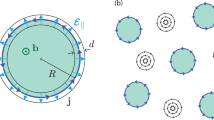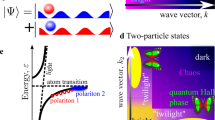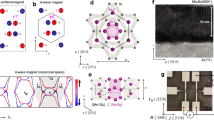Abstract
Superconducting quantum processors are a compelling platform for analogue quantum simulation due to the precision control, fast operation and site-resolved readout inherent to the hardware. Arrays of coupled superconducting qubits natively emulate the dynamics of interacting particles according to the Bose–Hubbard model. However, many interesting condensed-matter phenomena emerge only in the presence of electromagnetic fields. Here we emulate the dynamics of charged particles in an electromagnetic field using a superconducting quantum simulator. We realize a broadly adjustable synthetic magnetic vector potential by applying continuous modulation tones to all qubits. We verify that the synthetic vector potential obeys the required properties of electromagnetism: a spatially varying vector potential breaks time-reversal symmetry and generates a gauge-invariant synthetic magnetic field, and a temporally varying vector potential produces a synthetic electric field. We demonstrate that the Hall effect—the transverse deflection of a charged particle propagating in an electromagnetic field—exists in the presence of the synthetic electromagnetic field.
This is a preview of subscription content, access via your institution
Access options
Access Nature and 54 other Nature Portfolio journals
Get Nature+, our best-value online-access subscription
$32.99 / 30 days
cancel any time
Subscribe to this journal
Receive 12 print issues and online access
$259.00 per year
only $21.58 per issue
Buy this article
- Purchase on SpringerLink
- Instant access to full article PDF
Prices may be subject to local taxes which are calculated during checkout





Similar content being viewed by others
Data availability
Source data are provided with this paper. Additional data are available from the corresponding authors upon reasonable request and with the cognizance of our US Government sponsors who financed the work.
Code availability
The code used for numerical simulations and data analysis is available from the corresponding authors upon reasonable request and with the cognizance of our US Government sponsors who financed the work.
References
Greiner, M., Mandel, O., Esslinger, T., Hänsch, T. W. & Bloch, I. Quantum phase transition from a superfluid to a Mott insulator in a gas of ultracold atoms. Nature 415, 39–44 (2002).
Houck, A. A., Türeci, H. E. & Koch, J. On-chip quantum simulation with superconducting circuits. Nat. Phys. 8, 292–299 (2012).
Georgescu, I. M., Ashhab, S. & Nori, F. Quantum simulation. Rev. Mod. Phys. 86, 153–185 (2014).
Scholl, P. et al. Quantum simulation of 2D antiferromagnets with hundreds of Rydberg atoms. Nature 595, 233–238 (2021).
Altman, E. et al. Quantum simulators: architectures and opportunities. PRX Quantum 2, 017003 (2021).
Ebadi, S. et al. Quantum phases of matter on a 256-atom programmable quantum simulator. Nature 595, 227–232 (2021).
Preskill, J. Quantum computing in the NISQ era and beyond. Quantum 2, 79 (2018).
Kandala, A. et al. Error mitigation extends the computational reach of a noisy quantum processor. Nature 567, 491–495 (2019).
Daley, A. J. et al. Practical quantum advantage in quantum simulation. Nature 607, 667–676 (2022).
Kim, Y. et al. Evidence for the utility of quantum computing before fault tolerance. Nature 618, 500–505 (2023).
Schnyder, A. P., Ryu, S., Furusaki, A. & Ludwig, A. W. W. Classification of topological insulators and superconductors in three spatial dimensions. Phys. Rev. B 78, 195125 (2008).
Qi, X.-L. & Zhang, S.-C. Topological insulators and superconductors. Rev. Mod. Phys. 83, 1057–1110 (2011).
Alicea, J. New directions in the pursuit of Majorana fermions in solid state systems. Rep. Prog. Phys. 75, 076501 (2012).
von Klitzing, K. et al. 40 years of the quantum Hall effect. Nat. Rev. Phys. 2, 397–401 (2020).
Aharonov, Y. & Bohm, D. Significance of electromagnetic potentials in the quantum theory. Phys. Rev. 115, 485–491 (1959).
Little, W. A. & Parks, R. D. Observation of quantum periodicity in the transition temperature of a superconducting cylinder. Phys. Rev. Lett. 9, 9–12 (1962).
Hikami, S., Larkin, A. I. & Nagaoka, Y. Spin–orbit interaction and magnetoresistance in the two dimensional random system. Prog. Theor. Phys. 63, 707–710 (1980).
Taychatanapat, T., Watanabe, K., Taniguchi, T. & Jarillo-Herrero, P. Electrically tunable transverse magnetic focusing in graphene. Nat. Phys. 9, 225–229 (2013).
Ma, R. et al. A dissipatively stabilized Mott insulator of photons. Nature 566, 51–57 (2019).
Yan, Z. et al. Strongly correlated quantum walks with a 12-qubit superconducting processor. Science 364, 753–756 (2019).
Yanay, Y., Braumüller, J., Gustavsson, S., Oliver, W. D. & Tahan, C. Two-dimensional hard-core Bose–Hubbard model with superconducting qubits. npj Quantum Inf. 6, 58 (2020).
Saxberg, B. et al. Disorder-assisted assembly of strongly correlated fluids of light. Nature 612, 435–441 (2022).
Karamlou, A. H. et al. Quantum transport and localization in 1D and 2D tight-binding lattices. npj Quantum Inf. 8, 35 (2022).
Karamlou, A. H. et al. Probing entanglement in a 2D hard-core Bose–Hubbard lattice. Nature 629, 561–566 (2024).
Harper, P. G. Single band motion of conduction electrons in a uniform magnetic field. Proc. Phys. Soc. A 68, 874–878 (1955).
Hofstadter, D. R. Energy levels and wave functions of Bloch electrons in rational and irrational magnetic fields. Phys. Rev. B 14, 2239–2249 (1976).
Aidelsburger, M. et al. Realization of the Hofstadter Hamiltonian with ultracold atoms in optical lattices. Phys. Rev. Lett. 111, 185301 (2013).
Miyake, H., Siviloglou, G. A., Kennedy, C. J., Burton, W. C. & Ketterle, W. Realizing the Harper Hamiltonian with laser-assisted tunneling in optical lattices. Phys. Rev. Lett. 111, 185302 (2013).
Léonard, J. et al. Realization of a fractional quantum Hall state with ultracold atoms. Nature 619, 495–499 (2023).
Owens, J. C. et al. Chiral cavity quantum electrodynamics. Nat. Phys. 18, 1048–1052 (2022).
Aubry, S. & André, G. Analyticity breaking and Anderson localization in incommensurate lattices. Ann. Israel Phys. Soc. 3, 133–164 (1980).
Roushan, P. et al. Spectroscopic signatures of localization with interacting photons in superconducting qubits. Science 358, 1175–1179 (2017).
Li, H. et al. Observation of critical phase transition in a generalized Aubry–André–Harper model with superconducting circuits. npj Quantum Inf. 9, 40 (2023).
Xiang, Z.-C. et al. Simulating Chern insulators on a superconducting quantum processor. Nat. Commun. 14, 5433 (2023).
Koch, J. et al. Charge-insensitive qubit design derived from the Cooper pair box. Phys. Rev. A 76, 042319 (2007).
Alaeian, H. et al. Creating lattice gauge potentials in circuit QED: the bosonic Creutz ladder. Phys. Rev. A 99, 053834 (2019).
Zhao, S. K. et al. Probing operator spreading via Floquet engineering in a superconducting circuit. Phys. Rev. Lett. 129, 160602 (2022).
Lin, Y.-J. et al. A synthetic electric force acting on neutral atoms. Nat. Phys. 7, 531–534 (2011).
Rosenberg, D. et al. 3D integrated superconducting qubits. npj Quantum Inf. 3, 1 (2017).
Barrett, C. N. et al. Learning-based calibration of flux crosstalk in transmon qubit arrays. Phys. Rev. Appl. 20, 024070 (2023).
Peierls, R. Zur theorie des diamagnetismus von leitungselektronen. Z. Phys. 80, 763–791 (1933).
Gong, M. et al. Quantum walks on a programmable two-dimensional 62-qubit superconducting processor. Science 372, 948–952 (2021).
Martinez, J. G., Chiu, C. S., Smitham, B. M. & Houck, A. A. Flat-band localization and interaction-induced delocalization of photons. Sci. Adv. 9, eadj7195 (2023).
Preiss, P. M. et al. Strongly correlated quantum walks in optical lattices. Science 347, 1229–1233 (2015).
Guo, X.-Y. et al. Observation of Bloch oscillations and Wannier–Stark localization on a superconducting quantum processor. npj Quantum Inf. 7, 51 (2021).
Neill, C. et al. Accurately computing the electronic properties of a quantum ring. Nature 594, 508–512 (2021).
Niskanen, A. O., Nakamura, Y. & Tsai, J.-S. Tunable coupling scheme for flux qubits at the optimal point. Phys. Rev. B 73, 094506 (2006).
Chen, Y. et al. Qubit architecture with high coherence and fast tunable coupling. Phys. Rev. Lett. 113, 220502 (2014).
Yan, F. et al. Tunable coupling scheme for implementing high-fidelity two-qubit gates. Phys. Rev. Appl. 10, 054062 (2018).
Roushan, P. et al. Chiral ground-state currents of interacting photons in a synthetic magnetic field. Nat. Phys. 13, 146–151 (2017).
Wang, C. et al. Realization of fractional quantum Hall state with interacting photons. Science 384, 579–584 (2024).
Herzog-Arbeitman, J., Song, Z.-D., Regnault, N. & Bernevig, B. A. Hofstadter topology: noncrystalline topological materials at high flux. Phys. Rev. Lett. 125, 236804 (2020).
Saito, Y. et al. Hofstadter subband ferromagnetism and symmetry-broken Chern insulators in twisted bilayer graphene. Nat. Phys. 17, 478–481 (2021).
Haldane, F. D. M. Model for a quantum Hall effect without Landau levels: condensed-matter realization of the “parity anomaly”. Phys. Rev. Lett. 61, 2015–2018 (1988).
Jotzu, G. et al. Experimental realization of the topological Haldane model with ultracold fermions. Nature 515, 237–240 (2014).
Rosen, I. T. et al. Chiral transport along magnetic domain walls in the quantum anomalous Hall effect. npj Quantum Mater. 2, 69 (2017).
Yasuda, K. et al. Quantized chiral edge conduction on domain walls of a magnetic topological insulator. Science 358, 1311–1314 (2017).
Acknowledgements
We are grateful to P. M. Harrington, J. M. Gertler, A. L. Sharpe, B. Bakkali-Hassani, S. M. Girvin, L. S. Levitov, X.-G. Wen and T. P. Orlando for fruitful discussions. This material is based on work supported in part by the US Department of Energy, Office of Science, National Quantum Information Science Research Centers, Quantum System Accelerator (QSA; W.D.O.); in part by the Defense Advanced Research Projects Agency under the Quantum Benchmarking contract (J.A.G. and W.D.O.); in part by US Army Research Office Grant W911NF-23-1-0045 (W.D.O.); in part by the US Department of Energy, Office of Science, National Quantum Information Science Research Centers, Co-design Center for Quantum Advantage (C2QA) under contract number DE-SC0012704 (W.D.O.); and in part by the Department of Energy and Under Secretary of Defense for Research and Engineering under Air Force Contract No. FA8702-15-D-0001 (M.E.S. and J.L.Y.). I.T.R. and M.H. are supported by an appointment to the Intelligence Community Postdoctoral Research Fellowship Program at the Massachusetts Institute of Technology administered by Oak Ridge Institute for Science and Education (ORISE) through an interagency agreement between the US Department of Energy and the Office of the Director of National Intelligence (ODNI). S.M. is supported by a NASA Space Technology Research Fellowship. A.C. is partially supported by NSF DMR-2022428. D.A.R. acknowledges support from the National Science Foundation under award DMR-1747426. Any opinions, findings, conclusions, or recommendations expressed in this material are those of the author(s) and do not necessarily reflect the views of the Department of Energy, the Department of Defense, or the Under Secretary of Defense for Research and Engineering.
Author information
Authors and Affiliations
Contributions
I.T.R., A.C., M.H. and M.A.D. developed the theory for this work. I.T.R., S.M. and C.N.B. performed the experiments. A.H.K. developed infrastructure with support from D.A.R. R.D., D.K.K., B.M.N. and M.S. fabricated the device with coordination from K.S., M.E.S. and J.L.Y. J.A.G. and W.D.O. provided technical oversight and support. I.T.R. wrote the paper with contributions from all authors.
Corresponding authors
Ethics declarations
Competing interests
The authors declare no competing interests.
Peer review
Peer review information
Nature Physics thanks Long Nguyen and the other, anonymous, reviewer(s) for their contribution to the peer review of this work.
Additional information
Publisher’s note Springer Nature remains neutral with regard to jurisdictional claims in published maps and institutional affiliations.
Extended data
Extended Data Fig. 1 Localization at various synthetic electric field strengths.
The dynamics of a particle in an 11-site one-dimensional chain after being initialized at the central site. Dynamics at various synthetic electric field strengths are shown; field strengths are indicated at top in units of the coupling strength J. Experimental data are accompanied by simulations of the actual experiment and of an idealized model with a linear potential. When the synthetic electric field is zero, the particle propagates to the edges of the chain and reflects. As the electric field approaches J per site, Wannier-Stark localization of the particle becomes apparent: the particle does not reach the edges of the chain. At higher electric fields, the localization length decreases and the particle’s dynamics are tightly confined around its initial position.
Extended Data Fig. 2 Analysis of Hall effect data.
(a) The population \(\langle \hat{n}\rangle\) as a function of time. The data shown is for the site indicated by the orange circle in the inset measured at F = − 0.374J and \(\varPhi\) = π/12. The time-averaged population \(\langle \bar{n}\rangle\) of the site is indicated by the horizontal dashed line. (b) The value of \(\langle \bar{n}\rangle\) for each site (at F = − 0.374J, \(\varPhi\) = π/12), shown as a function of each site’s transverse position y. The orange point represents the site shown in the previous subpanel. The vertical teal line indicates the average y position of the particle \(\langle\bar{y}\rangle\). (c) The value of \(\langle\bar{y}\rangle\) at \(\varPhi\) = π/12 and different values of F. The teal point represents the value determined in the previous subpanel (F = − 0.374J). The brown line displays a linear fit to these data; we define the Hall coefficient \(\Delta \langle\bar{y}\rangle /\Delta F\) as its slope. (d) The Hall coefficient at different values of synthetic magnetic field. The brown point indicates the value determined in the previous subpanel (\(\varPhi\) = π/12).
Extended Data Fig. 3 Extracting Hall coefficients.
The average transverse deflection data shown in Fig. 5b are reproduced as a function of the synthetic electric field (circles). Linear fits (lines) are shown for each synthetic magnetic flux value, and are used to determine the Hall coefficients shown in Fig. 5c. Note that the deflection is nearly linear in F throughout the range of F measured.
Extended Data Fig. 4 Position versus time in the Hall effect experiment at synthetic magnetic flux π/6 per plaquette and at various synthetic electric field strengths.
(a) Average longitudinal position. (b) Average transverse position. Experimental data are shown at various synthetic electric field strengths and accompanied by simulations of the device and of the idealized Harper-Hofstadter model. Time is presented in units of inverse coupling strengths. Positions are written in units of unit cell length, for example, the initial position of the particle is (x, y) = (0, 0), and the position of the rightmost site is \((x,\,y)=(3\sqrt{2},\,0)\). Importantly, the longitudinal position of the particle is roughly the same for electric fields F and − F, yet the transverse deflection is not. This feature is not consistent with a description of the Hall effect in terms of a Lorentz force v × B for a classical velocity v. (c) The change in transverse deflection per change in flux, extracted from the data in Fig. 5b by linear fits of \(\langle\bar{y}\rangle\) versus synthetic magnetic flux. Values are shown as a function of synthetic electric field; the offset between experimental results and results from the idealized model in large part reflects the additional transverse deflection caused by inhomogeneity in the effective coupling strengths Jij across the lattice.
Extended Data Fig. 5 Layout for the parametric coupling scheme.
(a) A schematic of the 4 × 4 transmon array, with each qubit represented by a circle. The orientation matches diagrams in the main text figures, and each color describes the DC frequency setpoint of the corresponding qubit. (b) The color of each circle represents the frequency at which the corresponding qubit is modulated, and the color of each nearest-neighbor bond represents the detuning between the two adjacent qubits. Red shades indicate negative detunings (left colorbar), moving from left to right, while blue shades indicate positive detunings (right colorbar). (c) To realize a uniform synthetic magnetic field with \(\varPhi\) flux per plaquette, the modulation tone for each qubit is given the phase ϕi indicated by the color of the corresponding circle. The modulation phases generate the Peierls phases indicated by the purple arrows on each bond, where each arrow represents a Peierls phase of \(\varPhi\)/2. The flux threading each plaquette is the oriented sum of the Peierls phases around the plaquette; to define the sign of the flux, we take the sum along the counterclockwise oriented path.
Supplementary information
Supplementary Information
Supplementary Sections 1–8, Figs. 1–24 and Tables 1–3.
Source data
Source Data Fig. 1
Numerical data presented in Fig. 1f,g.
Source Data Fig. 2
Numerical data presented in Fig. 2a–c and all subpanels.
Source Data Fig. 3
Numerical data presented in Fig. 3a,b.
Source Data Fig. 4
Numerical data presented in Fig. 4b and all subpanels.
Source Data Fig. 5
Numerical data presented in Fig. 5b and all subpanels, and Fig. 5c.
Source Data Extended Data Fig. 1
Numerical data presented in all subpanels of Extended Data Fig. 1 plus intermediate values of the parameter F.
Source Data Extended Data Fig. 2
Numerical data presented in Extended Data Fig. 2a–d.
Source Data Extended Data Fig. 3
Numerical data presented in all subpanels of Extended Data Fig. 3.
Source Data Extended Data Fig. 4
Numerical data presented in Extended Data Fig. 4a–c and all subpanels.
Source Data Extended Data Fig. 5
Values for the information presented in all subpanels of Extended Data Fig. 5.
Rights and permissions
Springer Nature or its licensor (e.g. a society or other partner) holds exclusive rights to this article under a publishing agreement with the author(s) or other rightsholder(s); author self-archiving of the accepted manuscript version of this article is solely governed by the terms of such publishing agreement and applicable law.
About this article
Cite this article
Rosen, I.T., Muschinske, S., Barrett, C.N. et al. A synthetic magnetic vector potential in a 2D superconducting qubit array. Nat. Phys. 20, 1881–1887 (2024). https://doi.org/10.1038/s41567-024-02661-3
Received:
Accepted:
Published:
Issue date:
DOI: https://doi.org/10.1038/s41567-024-02661-3
This article is cited by
-
Programmable synthetic magnetism and chiral edge states in nano-optomechanical quantum Hall networks
Nature Communications (2025)
-
Strongly interacting Meissner phases in large bosonic flux ladders
Nature Physics (2025)
-
Superconducting circuits feel the pull of synthetic magnetism
Nature Physics (2024)



